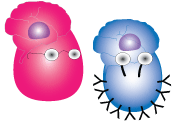
TCR and Ig recombination - creating diversity
The human genome project found that humans have approximately 35,000 functional genes. Approximately 1010 different Igs are generated by B cells in the bone marrow and approximately 109 different TCRs are formed by T cells in the thymus. How can this extensive diversity be created with so few genes? In the linker module we told you that there is diversity of MHC molecules because the body comes equipped with all of the different MHC genes ready-made. Not so for the Ig and TCR genes; they come with a label that says "some assembly required"!
Each variable domain of an Ig and a TCR is the product of a unique type of gene building exercise that only B and T cells can perform. B cell H chains and T cell β and δ chains link variable (V), diversity (D) and joining (J) gene segments together to form complete genes in a process called recombination. B cell L chains and T cell α and γ chains are formed from recombination of V and J gene segments only. All of the bits of genetic material to make a gene are there on a chromosome, but they are scattered around. The useful pieces need to be brought next to each other while the unwanted stretches get thrown out. You can see this for yourself in this flash animation where you decide which genes should recombine to produce a specific Ig L chain.
Did you notice how the two different gene segments came together like the back legs of a caterpillar coming close to the front legs? The body of the caterpillar forms a loop, as does the DNA molecule. The difference is that the entire DNA loop gets cut out and destroyed! Each time gene segments are joined, DNA breaks leaving chromosomes in pieces! What also happens, that was not shown in the flash animation, is that the free DNA ends are nibbled back, and 4 nucleotides are randomly added without instructions as to what order to put them in! This addition of nucleotides influences which antigen the finished Ig or TCR will bind and therefore also contributes to the diversity of Ig and TCR that are made. The modified ends finally get glued together. The variable domain then becomes attached to the constant region domain by rearranging RNA before the mRNA gets translated into protein, as we saw in the flash animation. All this time the B and T cells do not know what their Ig and TCR can bind!